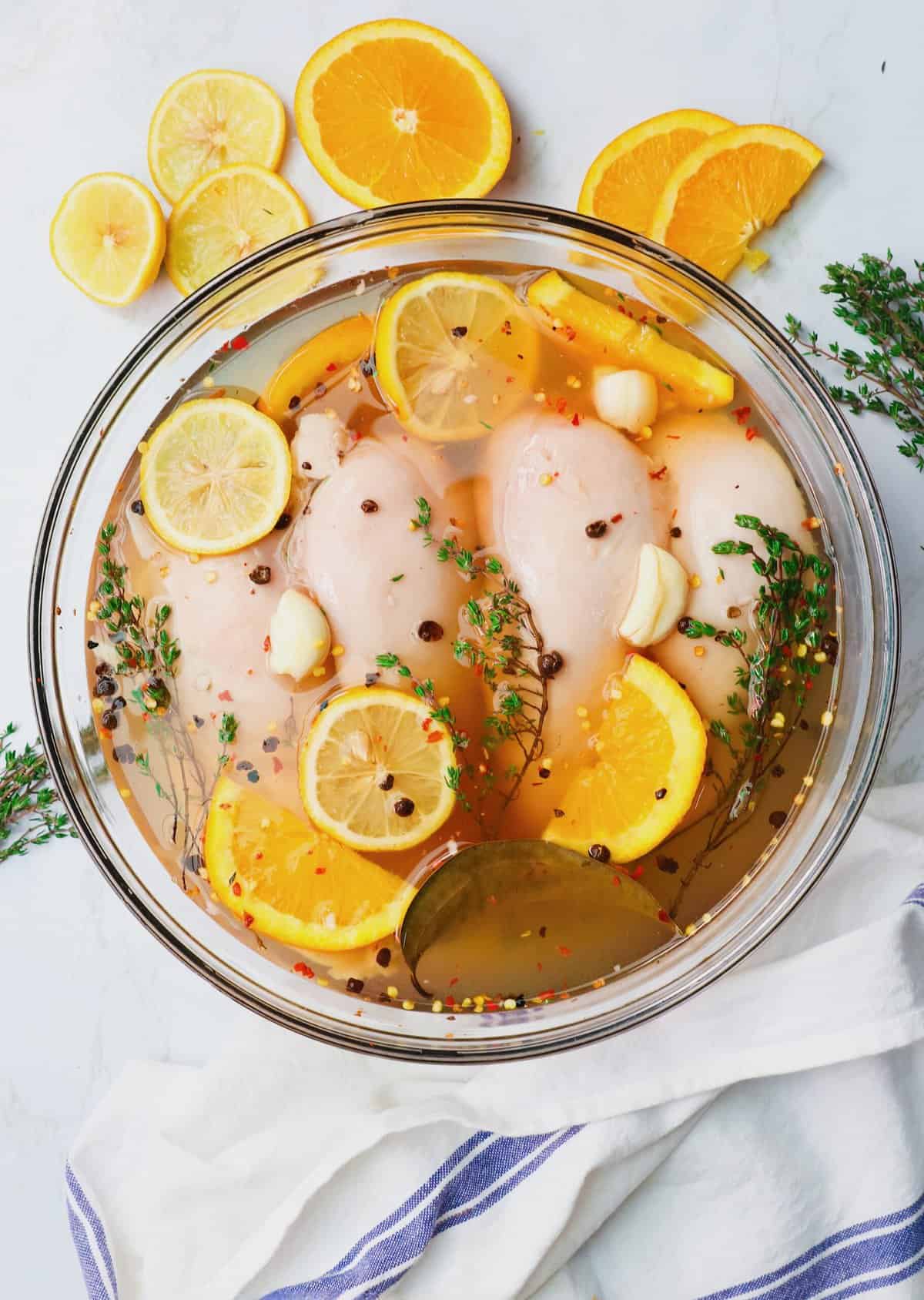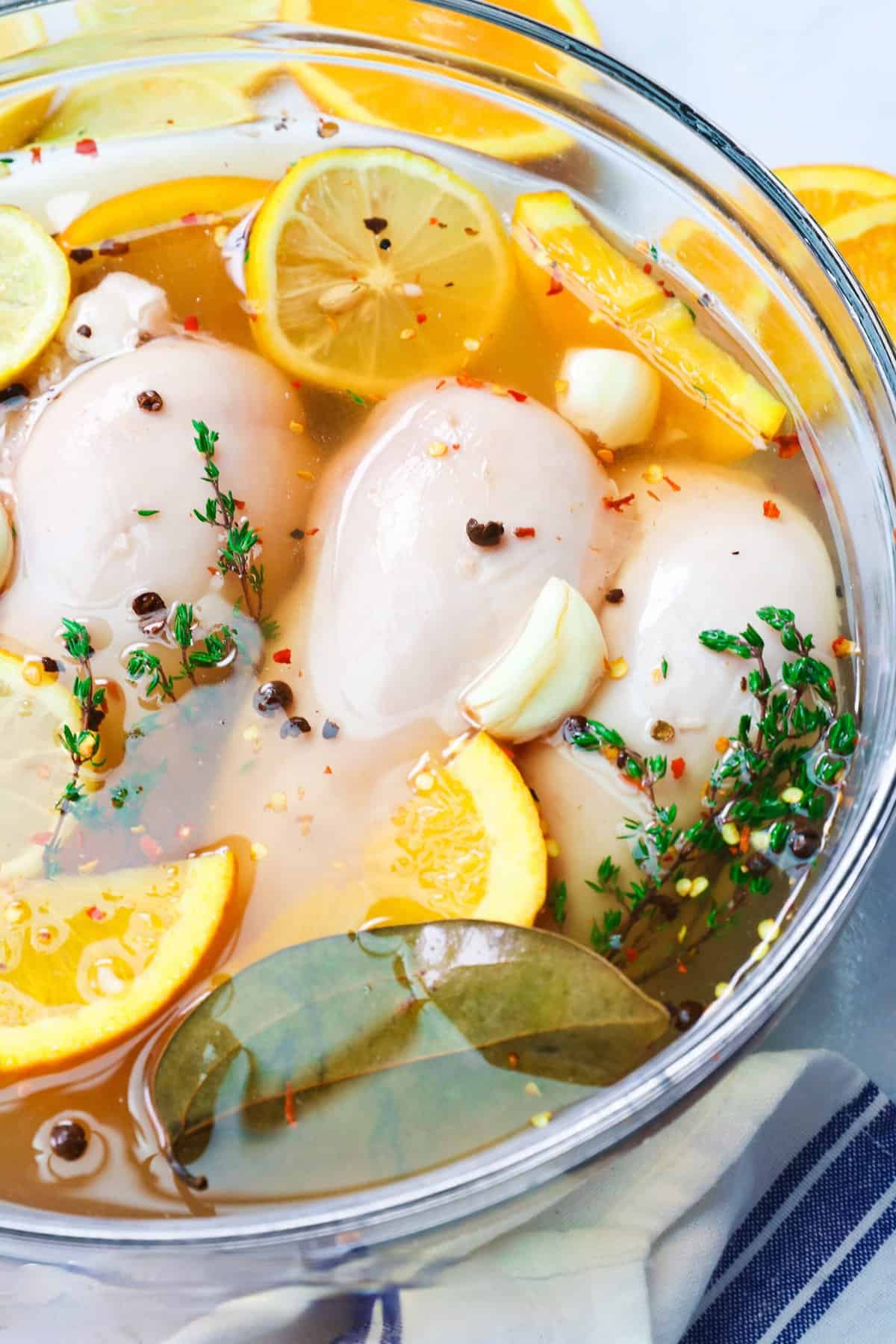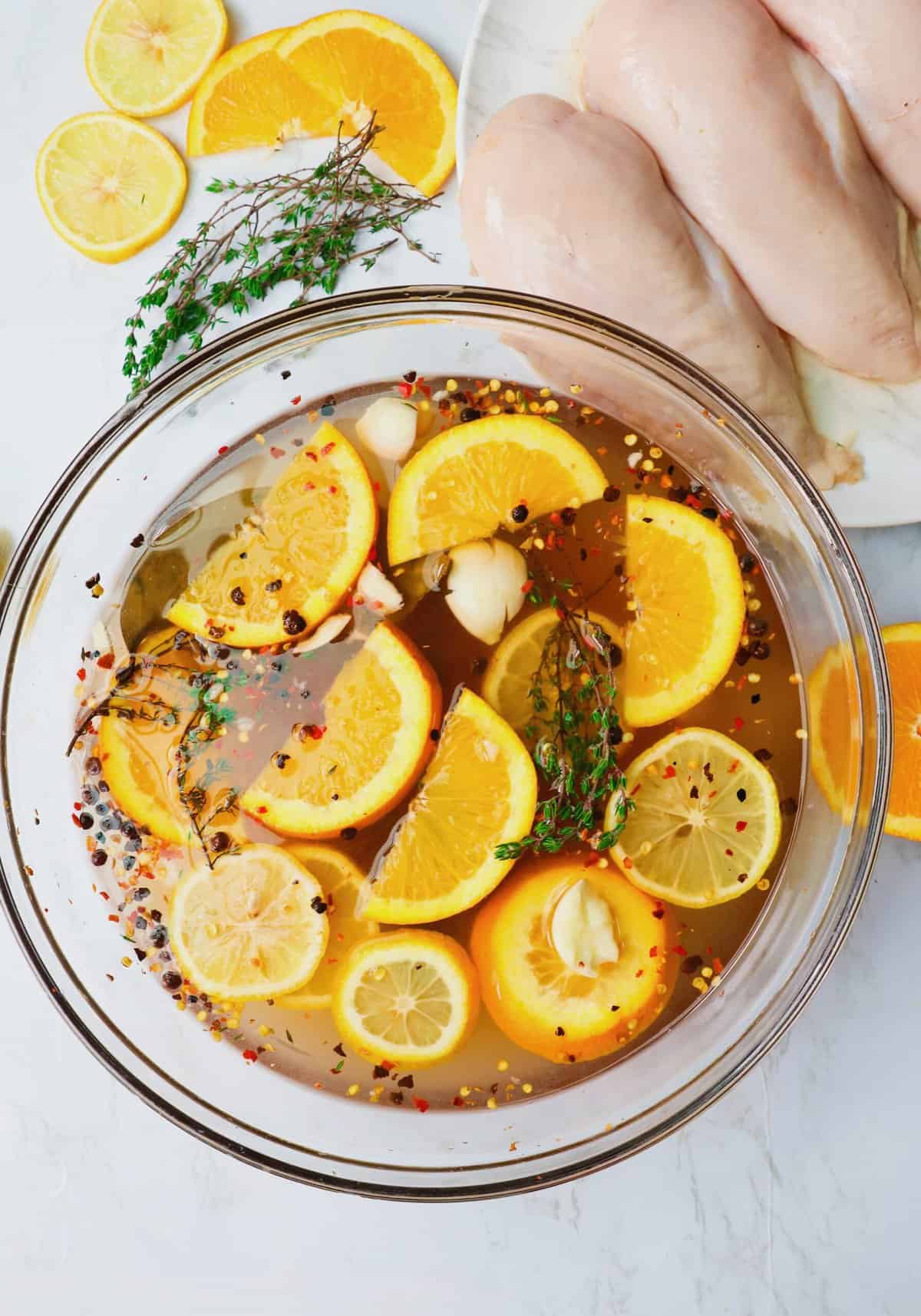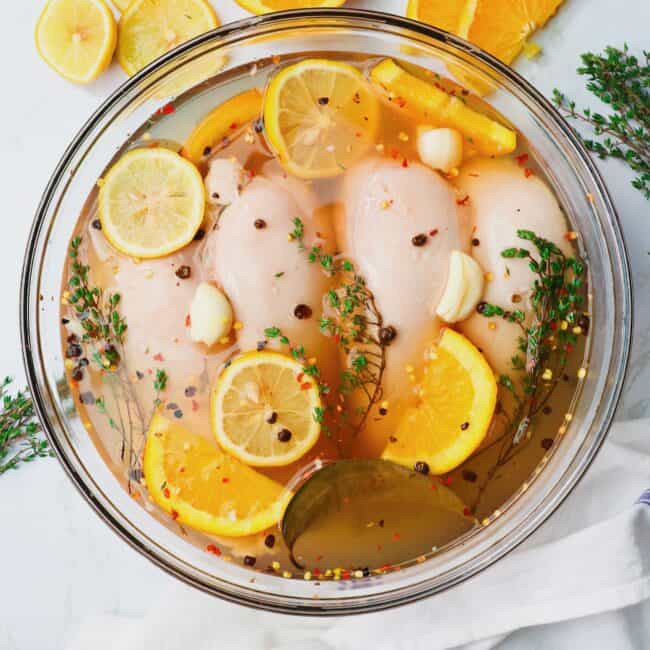Chicken Breast Brine – Make way for more succulent chicken meals! This tangy, herby, citrusy brine is all you need to take your chicken dishes from good to out of this world. It’s insanely easy and uses just a few pantry-staple ingredients. 😉

When I was growing up, my auntie was my cooking hero. Everything she touched turned delicious, and one of her specialties was grilled chicken. She could turn the cheapest, toughest cut into a juicy delicacy.
She almost always soaked raw chicken breasts in a mystery liquid, but one day she let me in on her secret: brine! It was a complete game-changer because brining is a foolproof way to get juicy chicken breasts every time. So say goodbye to dry chicken and prepare to brine!
Content…Why You Should Brine |

Why Should You Brine Chicken Breasts?
The brine starts breaking down the meat or chicken’s protein, allowing it to retain more moisture. And if you add seasoning, it also infuses flavor into your chicken. Moreover, the brine tenderizes it for magically juicy chicken every time!
Recipe Ingredients

- Chicken Breasts – The star of this recipe! Of course, you can also use bone-in, skin-on chicken breasts, wings, or thighs. Wings and thighs can sit in the brine for 6-8 hours, but the breast is a little more sensitive with a max of two hours.
- Liquids – Apple cider and water form the brine’s base. Apple cider kicks up the flavor and also acts as a tenderizer. But you can replace it with water if you wish.
- Kosher Salt – The key ingredient in any brine is salt. However, you do want kosher because iodine and anti-caking additives can make your brine cloudy and add a metallic taste.
- Brown Sugar – This sweet ingredient improves the browning and flavor of your brined chicken breasts. But feel free to leave it out if you’re doing paleo or keto.
- Seasonings – Garlic, thyme, and bay leaves add a subtle flavor and mouthwatering aroma. Then cracked peppercorn and red pepper flakes add some heat and excitement.
- Citrus – Orange and lemon provide a fresh, fruity flavor, and the acidity also helps tenderize the meat.
How to Brine Chicken Breasts

- Prep the Ingredients – Heat about a cup of water in the microwave or stovetop until warm. You want to heat it enough to dissolve the sugar and salt, not boil it. Remove it from the heat and pour in the salt and sugar. Stir until salt and sugar dissolve.
- Add Remaining Liquid – Let the salt and sugar brine cool, then add the remaining water and apple cider. The water should not be warm – you want it completely cooled.
- Brine the Chicken Breasts – Put the chicken breasts in a non-reactive pot or container and pour the brine over them. Then add garlic, thyme, bay leaves, peppercorns, pepper flakes, and the orange and lemon slices.
- Chill – Cover with a lid—place in the fridge for 45 minutes to an hour. But try not to go for more than an hour.
- Ready to Cook – Remove the chicken breasts from the brine and dry them with paper towels.
- Grill – Brush them with melted butter, rub with your desired seasoning, and head for the grill.

Recipe Variations
It’s easy to customize this recipe depending on your palate.
- Replace the apple cider with orange juice, wine, or beer for different flavor profiles.
- Craving Mexican? Add some fresh cilantro and sliced fresh jalapenos for a Latin twist!
- No thyme in the pantry? Substitute it with oregano or basil for a similar, herby flavor.
- Use regular granulated sugar, honey, maple syrup, or molasses instead of brown sugar.
Tips and Tricks
- Let your brine cool completely before adding the chicken. If you’re in a hurry, add ice cubes to the warm brine to speed up the cooling process.
- Brine chicken in a non-reactive container, such as glass, porcelain, plastic, or stainless steel. PLEASE, avoid aluminum, copper, and wood containers.
- Skinless, boneless chicken breasts can lose their wonderful texture if you brine them too long. An hour is my sweet spot, but I wouldn’t go over two hours if I could help it.
- Brined meat tends to cook faster. So once you start cooking, watch it and use a meat thermometer (165℉/75℃) to avoid overcooking.
- Do you ferment your own veggies or pickles? You can also use the brine from lacto-fermented veggies to brine your meat. Thank you, YouTube. 😉

FAQs
That depends if it’s the breast, wings, or thighs. For skinless, boneless chicken breasts, 30-60 minutes is the sweet spot. Bone-in, skin-on breasts can brine for up to 2 hours, thighs for 6 hours, and wings for up to 8 hours (or overnight).
Nope, not a good idea because salmonella isn’t fun. Even though you’ll be cooking the chicken, cross-contamination is still possible. Besides, this recipe comes together so quickly you can make new brine with all its savory goodness in minutes.
Brining aims to tenderize the meat and keep it moist. However, marinating focuses on getting incredible flavor into the meat. Brining is ideal for leaner cuts of meat, such as poultry, because it makes it juicier.
Yes, but it takes a bit of room in the fridge. It is easier to prepare the ingredients, then assemble everything when ready to brine. But you can brine your chicken the day before, take it out of the brine, drain it, and refrigerate it in an airtight container ready for tomorrow.
What to Serve With Brined Chicken Breast
For a hearty, decadent meal, scalloped potatoes and bacon broccoli salad are fantastic. Then add some pull-apart garlic rolls for an additional treat!
Or, for a lighter, equally tasty option, try pairing the chicken with sides of roast potatoes and carrots and avocado corn salad.
How to Use Your Brined Chicken Breasts
This is an excellent way to prepare chicken breasts for grilling, smoking, baking, and stuffing. Try it in any of these recipes.
- Smoked Chicken Breast
- Smoked Chicken Wings
- Oven Baked Chicken Breast
- Spinach Stuffed Chicken Breasts
- Crispy Caribbean Chicken Strips
- Cajun Stuffed Chicken
Conclusion
You’ll feel like a gourmet chef when you serve this perfectly tender, tasty chicken! Are you looking for more quick and easy weeknight meal options? Follow me on YouTube, and check out my easy, step-by-step videos!
Watch How to Make It
[adthrive-in-post-video-player video-id=”NnfZRuwa” upload-date=”2023-02-21T22:14:35.000Z” name=”CHICKEN BREAST BRINE.mp4″ description=”Chicken breast brine is tangy, herby, and citrusy and will take your chicken dishes from good to out of this world. And it’s insanely easy.” player-type=”collapse” override-embed=”false”]
Chicken Breast Brine
Ingredients
- 4 6-ounce boneless, skinless chicken breasts
- 5 cups cold water
- 5 cups apple cider (or replace with water)
- ½ cup kosher salt
- ⅙ cup brown sugar
- 3 cloves garlic, smashed
- 2 sprigs thyme
- 2 bay leaves
- 1 tablespoons cracked peppercorn
- 1 tablespoon red pepper flakes
- 1 large orange, sliced
- 1 lemon, sliced
Instructions
- Heat up about a cup of water in the microwave or stovetop until warm. The idea is to heat it enough to dissolve the sugar and salt, not boil it. Remove from heat and pour in the salt and sugar. Stir until salt and sugar dissolve.
- Let the salt and sugar brine cool, then add the remaining water and apple cider. The water should not be warm – you want it completely cool.
- Put the chicken breasts in a non-reactive pot or container and pour the brine over them. Then add garlic, thyme, bay leaves, peppercorns, pepper flakes, and the orange and lemon slices.
- Cover the pot or container with a lid, and place it in the fridge for 45 minutes to an hour. Try not to let it brine for more than an hour.
- Remove the chicken breasts from your brine and dry them with paper towels.
- Brush with butter and rub with your favorite seasoning, and they're now ready to grill, roast, bake, or smoke.
Tips & Notes:
- Let your brine cool completely before adding the chicken. If you’re in a hurry, add ice cubes to the warm brine to speed up the cooling process.
- Brine chicken in a non-reactive container, such as glass, porcelain, plastic, or stainless steel. PLEASE, avoid aluminum, copper, and wood containers.
- Don’t over-brine boneless, skinless chicken breasts! Leaving it in the solution over the recommended time may make it salty and spongy.
- Brined meat tends to cook faster. So once you start cooking, watch it and use a meat thermometer (165℉/75℃) to avoid overcooking.
- Do you ferment your own veggies or pickles? You can also use the brine from lacto-fermented veggies to brine your meat.
- Please remember that the nutritional information is a rough estimate and can vary significantly based on the products used in the recipe.

deborah dana says
this was flavorful and so moist. my only issue is that it seemed very salty compared with other brines i’ve done. i used morton coarse kosher salt for the brining and followed all other directions. i wonder if i shorter time brining than one hour would help. or should i use less salt? i used water and cider vinegar and actually replaced two cups of water with two cups of beer. i wonder if that is what made it saltier?
Imma says
Thanks so much for your feedback. Definitely brine it for a shorter time if you feel it was too salty. And since it’s refrigerated, you can also reduce the salt according to your preference
Deborah Dana says
thanks for your reply! i’ll try thaT
Imma says
Oh great to hear that. Thank you so much!
Margo Parker says
Using coarse salt could be your difference. It packs bigger punch. Might try using half as much next time
ImmaculateBites says
Hi Margo,
That’s a great observation! Coarse salt does have larger granules, which can lead to a saltier brine if you’re using the same volume measurement as you would for finer salt. Cutting back on the amount, as you suggested, is a good way to adjust the saltiness to your preference.
Thank you for sharing this tip. It’s insights like these that help everyone become a better home cook. Keep cooking and keep experimenting! ️✨
Marc Cascio says
This is amazing. I subbed some oj for the water (about half) and the chicken was super tasty. Thanks
Imma says
Oh great to hear that. Thank you so much!
Patrick Vennebush says
This recipe was awesome! Brining is my go-to for chiken breasts, but thos too itnup a notch. But Imma, I think the nutritional info is wrong… I suspect carbs and protein were flipped, as 54g of protein sounds much more reasonable.
Imma says
Thanks for pointing that out. The apple cider and brown sugar add carbs. But you’re right, there’s more protein in a chicken breast. I have fixed it.